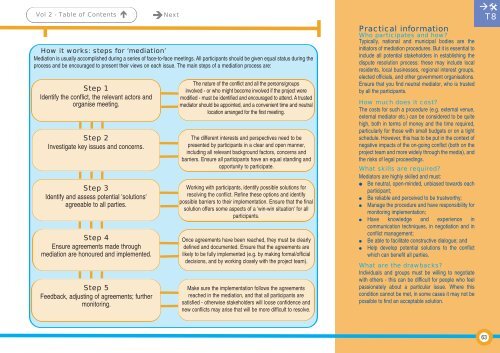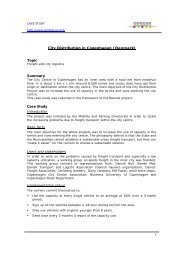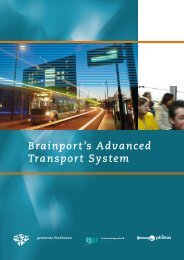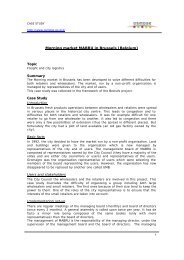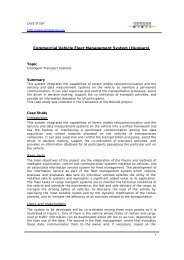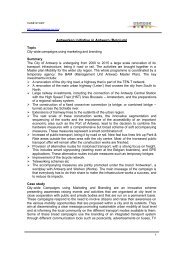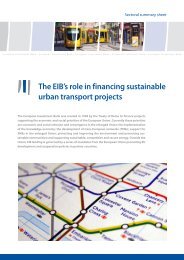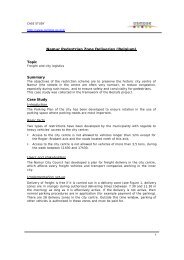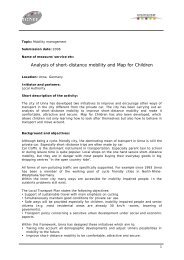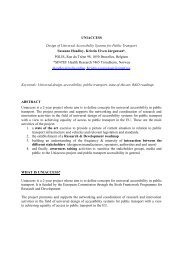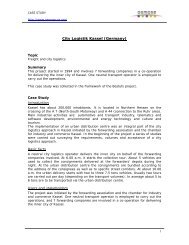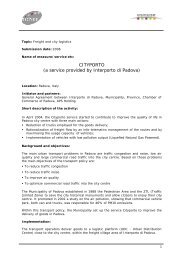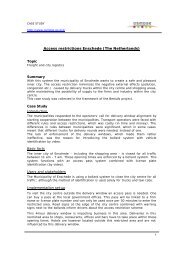Successful transport decision-making - Osmose
Successful transport decision-making - Osmose
Successful transport decision-making - Osmose
You also want an ePaper? Increase the reach of your titles
YUMPU automatically turns print PDFs into web optimized ePapers that Google loves.
Vol 2 - Table of Contents <br />
Next<br />
How it works: steps for ‘mediation’<br />
Mediation is usually accomplished during a series of face-to-face meetings. All participants should be given equal status during the<br />
process and be encouraged to present their views on each issue. The main steps of a mediation process are:<br />
Step 1<br />
Identify the conflict, the relevant actors and<br />
organise meeting.<br />
Step 2<br />
Investigate key issues and concerns.<br />
Step 3<br />
Identify and assess potential 'solutions'<br />
agreeable to all parties.<br />
Step 4<br />
Ensure agreements made through<br />
mediation are honoured and implemented.<br />
Step 5<br />
Feedback, adjusting of agreements; further<br />
monitoring.<br />
The nature of the conflict and all the persons/groups<br />
involved - or who might become involved if the project were<br />
modified - must be identified and encouraged to attend. A trusted<br />
mediator should be appointed, and a convenient time and neutral<br />
location arranged for the first meeting.<br />
The different interests and perspectives need to be<br />
presented by participants in a clear and open manner,<br />
including all relevant background factors, concerns and<br />
barriers. Ensure all participants have an equal standing and<br />
opportunity to participate.<br />
Working with participants, identify possible solutions for<br />
resolving the conflict. Refine these options and identify<br />
possible barriers to their implementation. Ensure that the final<br />
solution offers some aspects of a 'win-win situation' for all<br />
participants.<br />
Once agreements have been reached, they must be clearly<br />
defined and documented. Ensure that the agreements are<br />
likely to be fully implemented (e.g. by <strong>making</strong> formal/official<br />
<strong>decision</strong>s, and by working closely with the project team).<br />
Make sure the implementation follows the agreements<br />
reached in the mediation, and that all participants are<br />
satisfied - otherwise stakeholders will loose confidence and<br />
new conflicts may arise that will be more difficult to resolve.<br />
Practical information<br />
Who participates and how?<br />
Typically, national and municipal bodies are the<br />
initiators of mediation procedures. But it is essential to<br />
include all potential stakeholders in establishing the<br />
dispute resolution process: these may include local<br />
residents, local businesses, regional interest groups,<br />
elected officials, and other government organisations.<br />
Ensure that you find neutral mediator, who is trusted<br />
by all the participants.<br />
How much does it cost?<br />
The costs for such a procedure (e.g. external venue,<br />
external mediator etc.) can be considered to be quite<br />
high, both in terms of money and the time required,<br />
particularly for those with small budgets or on a tight<br />
schedule. However, this has to be put in the context of<br />
negative impacts of the on-going conflict (both on the<br />
project team and more widely through the media), and<br />
the risks of legal proceedings.<br />
What skills are required?<br />
Mediators are highly skilled and must:<br />
Be neutral, open-minded, unbiased towards each<br />
participant;<br />
<br />
<br />
Be reliable and perceived to be trustworthy;<br />
Manage the procedure and have responsibility for<br />
monitoring implementation;<br />
Have knowledge and experience in<br />
communication techniques, in negotiation and in<br />
conflict management;<br />
<br />
<br />
Be able to facilitate constructive dialogue; and<br />
Help develop potential solutions to the conflict<br />
which can benefit all parties.<br />
What are the drawbacks?<br />
Individuals and groups must be willing to negotiate<br />
with others - this can be difficult for people who feel<br />
passionately about a particular issue. Where this<br />
condition cannot be met, in some cases it may not be<br />
possible to find an acceptable solution.<br />
<br />
T8<br />
63


